The NeuroinflammatoryPotential of HIV-1 NefVariants in Modulating the Gene Expression Profile of Astrocytes
Abstract
1. Introduction
2. Materials and Methods
2.1. Details of the Study Samples
2.2. Amplification and Genetic Analysis of HIV nef Gene Sequence
2.3. Cell Culture and Estimation of Cell Viability
2.4. Construction of Plasmids for Transfection
2.5. Plasmid and siRNA-nef Transfection in NHA
2.6. Real-Time RT-PCR and Multiplex Cytokine Assay
2.7. Western Blotting
2.8. Estimation of Nitric Oxide as a Biomarker of Oxidative Stress
2.9. Statistical Analyses
3. Results
3.1. Study Participants
3.2. HIV nef Amplification, Sequencing, and Plasmid Construction
3.3. Prediction of HLA-Binding Epitopes
3.4. Determination of Cytotoxicity of siRNA-Nef
3.5. Transfection of Normal Human Astrocytes
3.6. Estimation of Nef Expression before and after RNA Interference
3.7. Expression of Cytokines, and Kynurenine Metabolites in NHA
3.8. Nef Protein Expression by Western Blotting
3.9. Downregulation of Cytokines due to siRNA-NefInterference
3.10. Downregulation in Kynurenine Metabolites due to RNA Interference
3.11. The Level of Nitric Oxide (NO) Concentration before and after RNA Interference
4. Discussion
5. Conclusions
Author Contributions
Funding
Institutional Review Board Statement
Informed Consent Statement
Data Availability Statement
Conflicts of Interest
References
- Updated Information about HIV Prevalence Was Accessed in April 2022. Available online: https://www.unaids.org/sites/default/files/media_asset/JC3032_AIDS_Data_book_2021_En.pdf (accessed on 28 July 2022).
- Zuo, J.; Suen, J.; Wong, A.; Lewis, M.; Ayub, A.; Belzer, M.; Church, J.; Yang, O.O.; Krogstad, P. Functional Analysis of HIV Type 1 Nef Gene Variants from Adolescent and Adult Survivors of Perinatal Infection. AIDS Res. Hum. Retrovir. 2012, 28, 486–492. [Google Scholar] [CrossRef]
- Tedaldi, E.M.; Minniti, N.L.; Fischer, T. HIV-Associated Neurocognitive Disorders: The Relationship of HIV Infection with Physical and Social Comorbidities. BioMed Res. Int. 2015, 2015, 641913. [Google Scholar] [CrossRef] [PubMed]
- Ng’uni, T.; Chasara, C.; Ndhlovu, Z.M. Major Scientific Hurdles in HIV Vaccine Development: Historical Perspective and Future Directions. Front. Immunol. 2020, 11, 590780. [Google Scholar] [CrossRef] [PubMed]
- Saylor, D.; Dickens, A.M.; Sacktor, N.; Haughey, N.; Slusher, B.; Pletnikov, M.; Mankowski, J.L.; Brown, A.; Volsky, D.J.; McArthur, J.C. HIV-Associated Neurocognitive Disorder—Pathogenesis and Prospects for Treatment. Nat. Rev. Neurol. 2016, 12, 234–248. [Google Scholar] [CrossRef] [PubMed]
- Milanini, B.; Paul, R.; Bahemana, E.; Adamu, Y.; Kiweewa, F.; Langat, R.; Owuoth, J.; Allen, E.; Polyak, C.; Ake, J.; et al. Limitations of the International HIV Dementia Scale in the Current Era. AIDS 2018, 32, 2477–2483. [Google Scholar] [CrossRef] [PubMed]
- Matchanova, A.; Woods, S.P.; Kordovski, V.M. Operationalizing and Evaluating the Frascati Criteria for Functional Decline in Diagnosing HIV-Associated Neurocognitive Disorders in Adults. J. Neurovirol. 2020, 26, 155–167. [Google Scholar] [CrossRef]
- Bandera, A.; Taramasso, L.; Bozzi, G.; Muscatello, A.; Robinson, J.A.; Burdo, T.H.; Gori, A. HIV-Associated Neurocognitive Impairment in the Modern ART Era: Are We Close to Discovering Reliable Biomarkers in the Setting of Virological Suppression? Front. Aging Neurosci. 2019, 11, 187. [Google Scholar] [CrossRef]
- Kovalevich, J.; Langford, D. Neuronal Toxicity in HIV CNS Disease. Future Virol. 2012, 7, 687–698. [Google Scholar] [CrossRef]
- Thaney, V.E.; Sanchez, A.B.; Fields, J.A.; Minassian, A.; Young, J.W.; Maung, R.; Kaul, M. Transgenic Mice Expressing HIV-1 Envelope Protein Gp120 in the Brain as an Animal Model in NeuroAIDS Research. J. Neurovirol. 2018, 24, 156–167. [Google Scholar] [CrossRef]
- Ajasin, D.; Eugenin, E.A. HIV-1 Tat: Role in Bystander Toxicity. Front. Cell. Infect. Microbiol. 2020, 10, 61. [Google Scholar] [CrossRef]
- Yarandi, S.S.; Duggan, M.R.; Sariyer, I.K. Emerging Role of Nef in the Development of HIV Associated Neurological Disorders. J. Neuroimmune Pharm. 2021, 16, 238–250. [Google Scholar] [CrossRef] [PubMed]
- Jin, S.W.; Mwimanzi, F.M.; Mann, J.K.; Bwana, M.B.; Lee, G.Q.; Brumme, C.J.; Hunt, P.W.; Martin, J.N.; Bangsberg, D.R.; Ndung’u, T.; et al. Variation in HIV-1 Nef Function within and among Viral Subtypes Reveals Genetically Separable Antagonism of SERINC3 and SERINC5. PLoS Pathog. 2020, 16, e1008813. [Google Scholar] [CrossRef] [PubMed]
- Clifford, D.B.; Ances, B.M. HIV-Associated Neurocognitive Disorder. Lancet Infect. Dis. 2013, 13, 976–986. [Google Scholar] [CrossRef]
- Yarandi, S.S.; Robinson, J.A.; Vakili, S.; Donadoni, M.; Burdo, T.H.; Sariyer, I.K. Characterization of Nef Expression in Different Brain Regions of SIV-Infected Macaques. PLoS ONE 2020, 15, e0241667. [Google Scholar] [CrossRef] [PubMed]
- Pužar Dominkuš, P.; Ferdin, J.; Plemenitaš, A.; Peterlin, B.M.; Lenassi, M. Nef Is Secreted in Exosomes from Nef.GFP-Expressing and HIV-1-Infected Human Astrocytes. J. Neurovirol. 2017, 23, 713–724. [Google Scholar] [CrossRef] [PubMed]
- Rivera, J.; Isidro, R.A.; Loucil-Alicea, R.Y.; Cruz, M.L.; Appleyard, C.B.; Isidro, A.A.; Chompre, G.; Colon-Rivera, K.; Noel, R.J. Infusion of HIV-1 Nef-Expressing Astrocytes into the Rat Hippocampus Induces Enteropathy and Interstitial Pneumonitis and Increases Blood–Brain-Barrier Permeability. PLoS ONE 2019, 14, e0225760. [Google Scholar] [CrossRef] [PubMed]
- Basmaciogullari, S.; Pizzato, M. The Activity of Nef on HIV-1 Infectivity. Front. Microbiol. 2014, 5, 232. [Google Scholar] [CrossRef]
- Pawlak, E.N.; Dirk, B.S.; Jacob, R.A.; Johnson, A.L.; Dikeakos, J.D. The HIV-1 Accessory Proteins Nef and Vpu Downregulate Total and Cell Surface CD28 in CD4+ T Cells. Retrovirology 2018, 15, 6. [Google Scholar] [CrossRef]
- Trifone, C.; Salido, J.; Ruiz, M.J.; Leng, L.; Quiroga, M.F.; Salomón, H.; Bucala, R.; Ghiglione, Y.; Turk, G. Interaction Between Macrophage Migration Inhibitory Factor and CD74 in Human Immunodeficiency Virus Type I Infected Primary Monocyte-Derived Macrophages Triggers the Production of Proinflammatory Mediators and Enhances Infection of Unactivated CD4+ T Cells. Front. Immunol. 2018, 9, 1494. [Google Scholar] [CrossRef]
- Mann, J.K.; Rajkoomar, E.; Jin, S.W.; Mkhize, Q.; Baiyegunhi, O.; Mbona, P.; Brockman, M.A.; Ndung’u, T. Consequences of HLA-associated Mutations in HIV-1 Subtype C Nef on HLA-I Downregulation Ability. J. Med. Virol. 2020, 92, 1182–1190. [Google Scholar] [CrossRef]
- Felli, C.; Vincentini, O.; Silano, M.; Masotti, A. HIV-1 Nef Signaling in Intestinal Mucosa Epithelium Suggests the Existence of an Active Inter-Kingdom Crosstalk Mediated by Exosomes. Front. Microbiol. 2017, 8, 1022. [Google Scholar] [CrossRef] [PubMed]
- Mumby, M.J.; Johnson, A.L.; Trothen, S.M.; Edgar, C.R.; Gibson, R.; Stathopulos, P.B.; Arts, E.J.; Dikeakos, J.D. An Amino Acid Polymorphism within the HIV-1 Nef Dileucine Motif Functionally Uncouples Cell Surface CD4 and SERINC5 Downregulation. J. Virol. 2021, 95, e00588-21. [Google Scholar] [CrossRef] [PubMed]
- Liu, X.; Kumar, A. Differential Signaling Mechanism for HIV-1 Nef-Mediated Production of IL-6 and IL-8 in Human Astrocytes. Sci. Rep. 2015, 5, 9867. [Google Scholar] [CrossRef] [PubMed]
- Liu, M.; Han, X.; Zhao, B.; An, M.; He, W.; Wang, Z.; Qiu, Y.; Ding, H.; Shang, H. Dynamics of HIV-1 Molecular Networks Reveal Effective Control of Large Transmission Clusters in an Area Affected by an Epidemic of Multiple HIV Subtypes. Front. Microbiol. 2020, 11, 604993. [Google Scholar] [CrossRef] [PubMed]
- Castro-Nallar, E.; Pérez-Losada, M.; Burton, G.F.; Crandall, K.A. The Evolution of HIV: Inferences Using Phylogenetics. Mol. Phylogenet. Evol. 2012, 62, 777–792. [Google Scholar] [CrossRef] [PubMed]
- Li, L.; Dahiya, S.; Kortagere, S.; Aiamkitsumrit, B.; Cunningham, D.; Pirrone, V.; Nonnemacher, M.R.; Wigdahl, B. Impact of Tat Genetic Variation on HIV-1 Disease. Adv. Virol. 2012, 2012, 123605. [Google Scholar] [CrossRef] [PubMed]
- Baran, H.; Hainfellner, J.A.; Kepplinger, B. Kynurenic Acid Metabolism in Various Types of Brain Pathology in HIV-1 Infected Patients. Int. J.Tryptophan. Res. 2012, 5, IJTR.S10627. [Google Scholar] [CrossRef]
- Lovelace, M.D.; Varney, B.; Sundaram, G.; Franco, N.F.; Ng, M.L.; Pai, S.; Lim, C.K.; Guillemin, G.J.; Brew, B.J. Current Evidence for a Role of the Kynurenine Pathway of Tryptophan Metabolism in Multiple Sclerosis. Front. Immunol. 2016, 7, 246. [Google Scholar] [CrossRef]
- Muneer, A. Kynurenine Pathway of Tryptophan Metabolism in Neuropsychiatric Disorders: Pathophysiologic and Therapeutic Considerations. Clin. Psychopharmacol. Neurosci. 2020, 18, 507–526. [Google Scholar] [CrossRef]
- Geng, J.; Altman, J.D.; Krishnakumar, S.; Raghavan, M. Empty Conformers of HLA-B Preferentially Bind CD8 and Regulate CD8+ T Cell Function. eLife 2018, 7, e36341. [Google Scholar] [CrossRef]
- Gupta, P.; Husain, M.; Hans, C.; Ram, H.; Verma, S.S.; Misbah, M.; Chauhan, L.S.; Rai, A. Sequence Heterogeneity in Human Immunodeficiency Virus Type 1 Nef in Patients Presenting with Rapid Progression and Delayed Progression to AIDS. Arch. Virol. 2014, 159, 2303–2320. [Google Scholar] [CrossRef] [PubMed]
- Lehmann, D.J.; Barnardo, M.C.; Fuggle, S.; Quiroga, I.; Sutherland, A.; Warden, D.R.; Barnetson, L.; Horton, R.; Beck, S.; Smith, A.D. Replication of the association of HLA-B7 with Alzheimer’s disease: A role for homozygosity? J. Neuroinflamm. 2006, 3, 33. [Google Scholar] [CrossRef] [PubMed][Green Version]
- Van Marle, G.; Henry, S.; Todoruk, T.; Sullivan, A.; Silva, C.; Rourke, S.B.; Holden, J.; McArthur, J.C.; Gill, M.J.; Power, C. Human Immunodeficiency Virus Type 1 Nef Protein Mediates Neural Cell Death: A Neurotoxic Role for IP-10. Virology 2004, 329, 302–318. [Google Scholar] [CrossRef] [PubMed]
- Fischer-Smith, T.; Bell, C.; Croul, S.; Lewis, M.; Rappaport, J. Monocyte/Macrophage Trafficking in Acquired Immunodeficiency Syndrome Encephalitis: Lessons from Human and Nonhuman Primate Studies. J Neurovirol. 2008, 14, 318–326. [Google Scholar] [CrossRef]
- Guillemin, G.J.; Kerr, S.J.; Smythe, G.A.; Smith, D.G.; Kapoor, V.; Armati, P.J.; Croitoru, J.; Brew, B.J. Kynurenine Pathway Metabolism in Human Astrocytes: A Paradox for Neuronal Protection: Kynurenine Pathway in Astrocytes. J. Neurochem. 2001, 78, 842–853. [Google Scholar] [CrossRef] [PubMed]
- Sporer, B.; Koedel, U.; Paul, R.; Kohleisen, B.; Erfle, V.; Fontana, A.; Pfister, H.W. Human Immunodeficiency Virus Type-1 Nef Protein Induces Blood-Brain Barrier Disruption in the Rat: Role of Matrix Metalloproteinase-9. J. Neuroimmunol. 2000, 102, 125–130. [Google Scholar] [CrossRef]
- Trillo-Pazos, G.; McFarlane-Abdulla, E.; Campbell, I.C.; Pilkington, G.J.; Everall, I.P. Recombinant Nef HIV-IIIB Protein Is Toxic to Human Neurons in Culture. Brain Res. 2000, 864, 315–326. [Google Scholar] [CrossRef]
- Aqil, M.; Naqvi, A.R.; Mallik, S.; Bandyopadhyay, S.; Maulik, U.; Jameel, S. The HIV Nef Protein Modulates Cellular and Exosomal MiRNA Profiles in Human Monocytic Cells. J. Extracell. Vesicles 2014, 3, 23129. [Google Scholar] [CrossRef]
- Kohleisen, B.; Shumay, E.; Sutter, G.; Foerster, R.; Brack-Werner, R.; Nuesse, M.; Erfle, V. Stable Expression of HIV-1 Nef Induces Changes in Growth Properties and Activation State of Human Astrocytes. AIDS 1999, 13, 2331–2341. [Google Scholar] [CrossRef]
- Robichaud, G.A.; Poulin, L. HIV Type 1 Nef Gene Inhibits Tumor Necrosis Factor α-Induced Apoptosis and Promotes Cell Proliferation through the Action of MAPK and JNK in Human Glial Cells. AIDS Res. Hum. Retrovir. 2000, 16, 1959–1965. [Google Scholar] [CrossRef]
- Kany, S.; Vollrath, J.T.; Relja, B. Cytokines in Inflammatory Disease. IJMS 2019, 20, 6008. [Google Scholar] [CrossRef] [PubMed]
- Suphaphiphat, K.; Bernard-Stoecklin, S.; Gommet, C.; Delache, B.; Dereuddre-Bosquet, N.; Kent, S.J.; Wines, B.D.; Hogarth, P.M.; Le Grand, R.; Cavarelli, M. Innate and Adaptive Anti-SIV Responses in Macaque Semen: Implications for Infectivity and Risk of Transmission. Front. Immunol. 2020, 11, 850. [Google Scholar] [CrossRef] [PubMed]
- Lichterfeld, M.; Yu, X.G.; Cohen, D.; Addo, M.M.; Malenfant, J.; Perkins, B.; Pae, E.; Johnston, M.N.; Strick, D.; Allen, T.M.; et al. HIV-1 Nef Is Preferentially Recognized by CD8 T Cells in Primary HIV-1 Infection despite a Relatively High Degree of Genetic Diversity. AIDS 2004, 18, 1383–1392. [Google Scholar] [CrossRef] [PubMed]

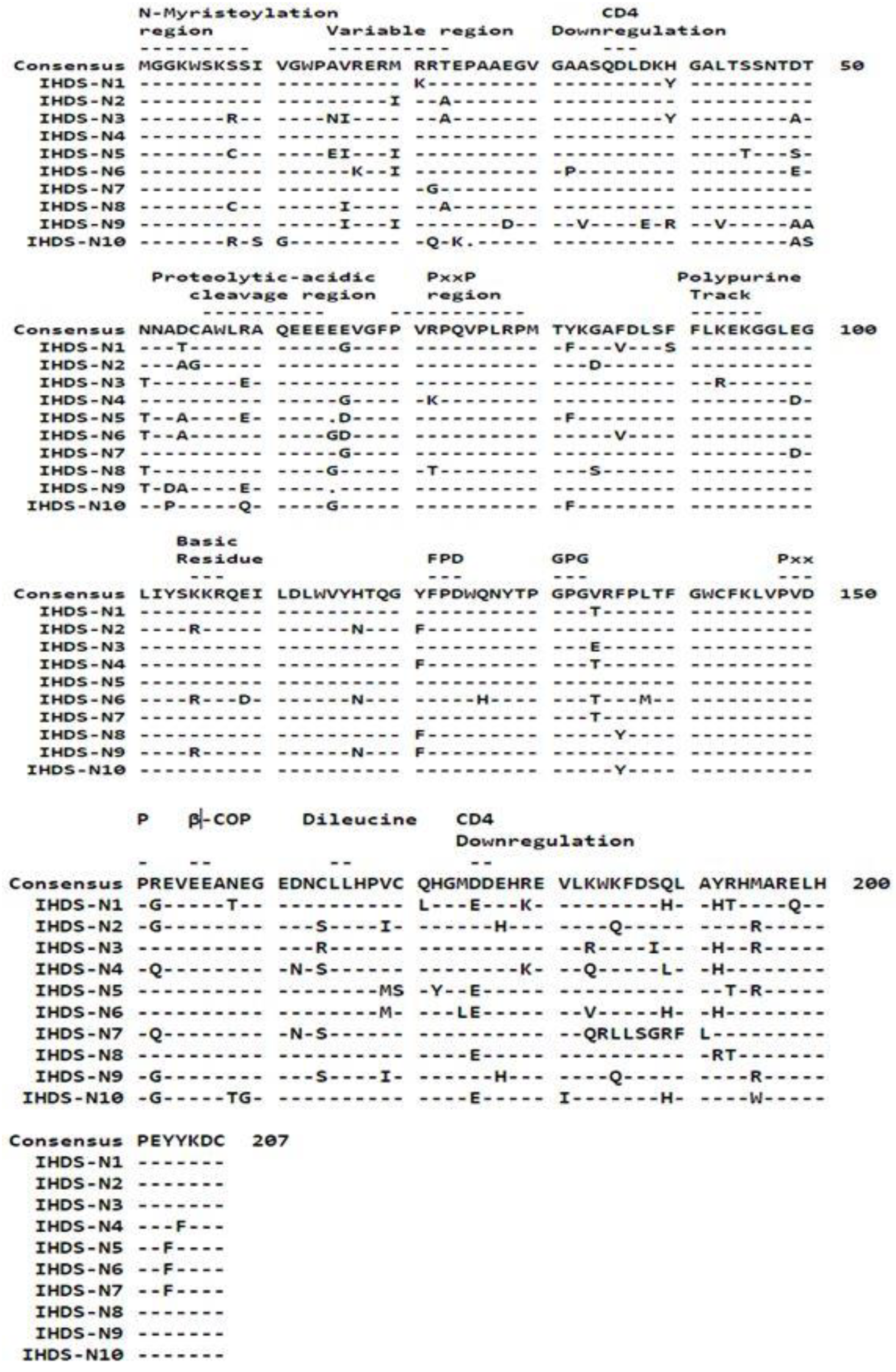
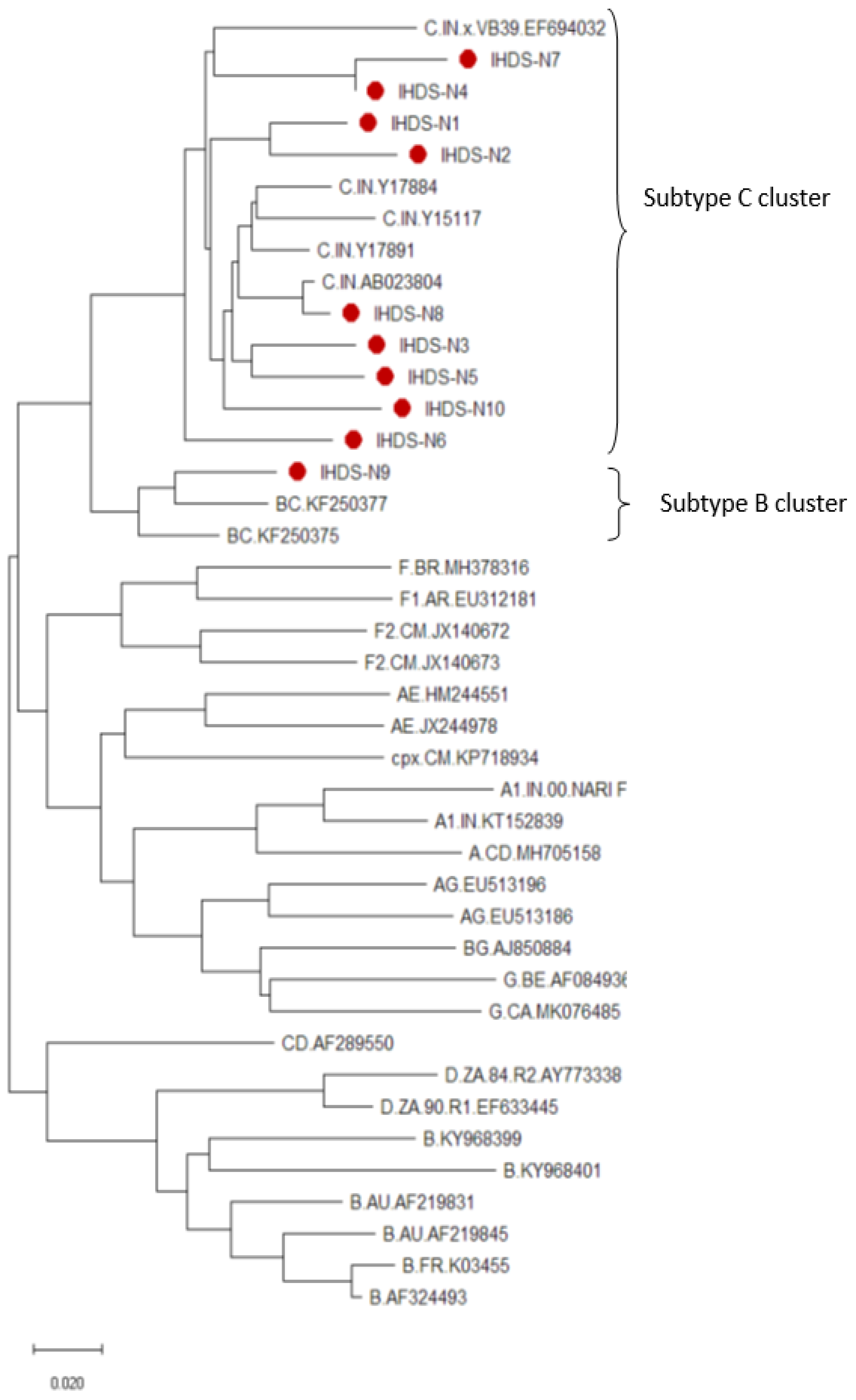
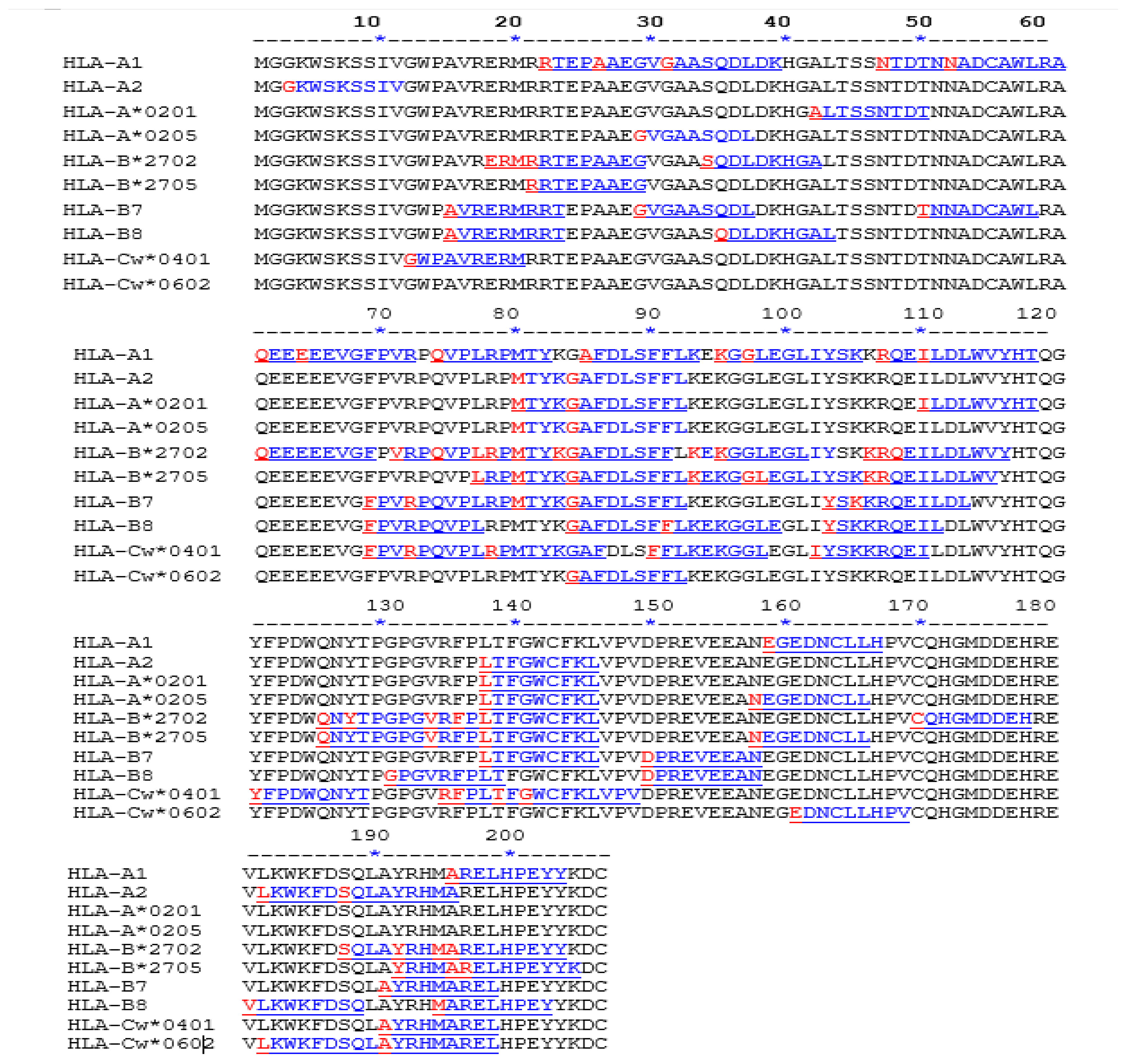
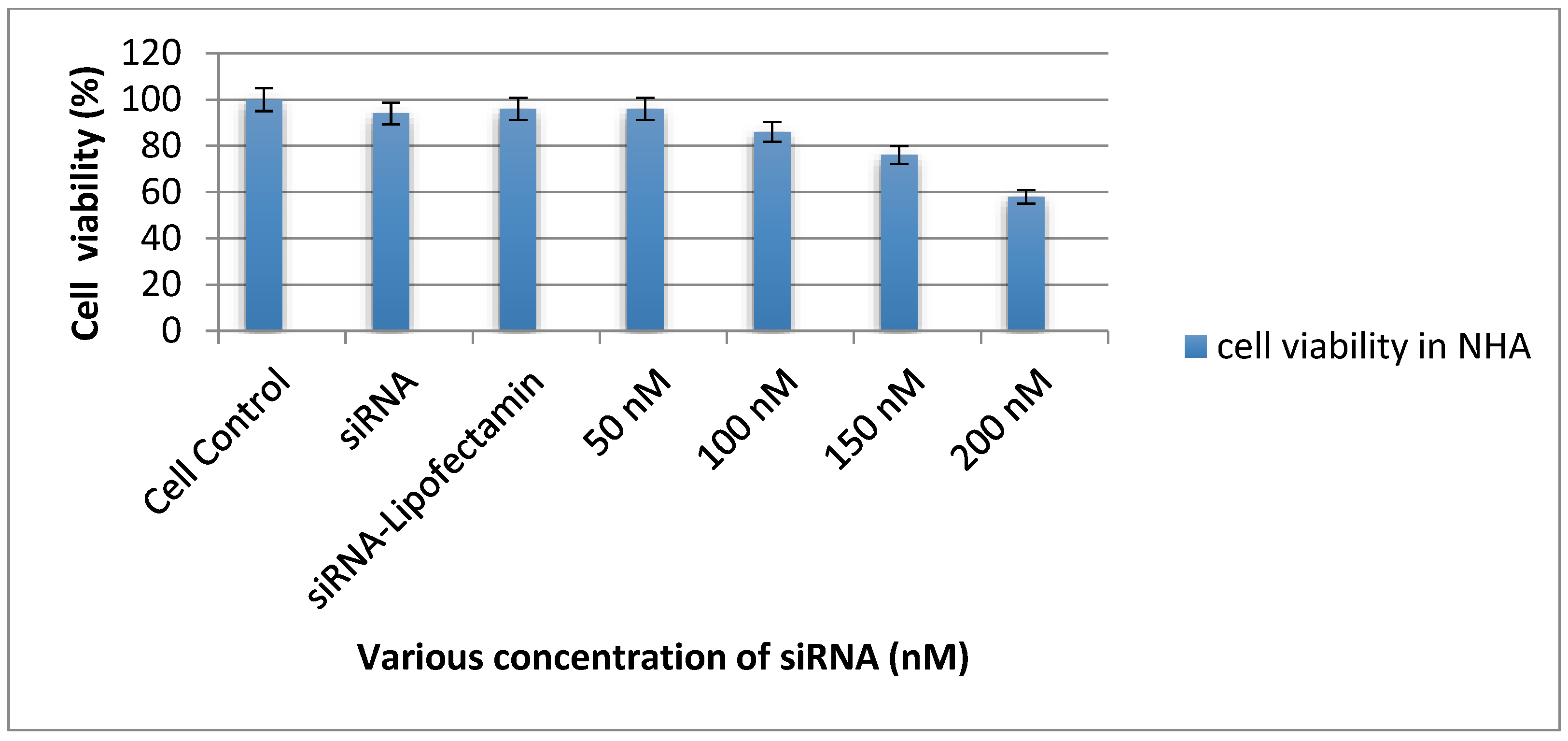
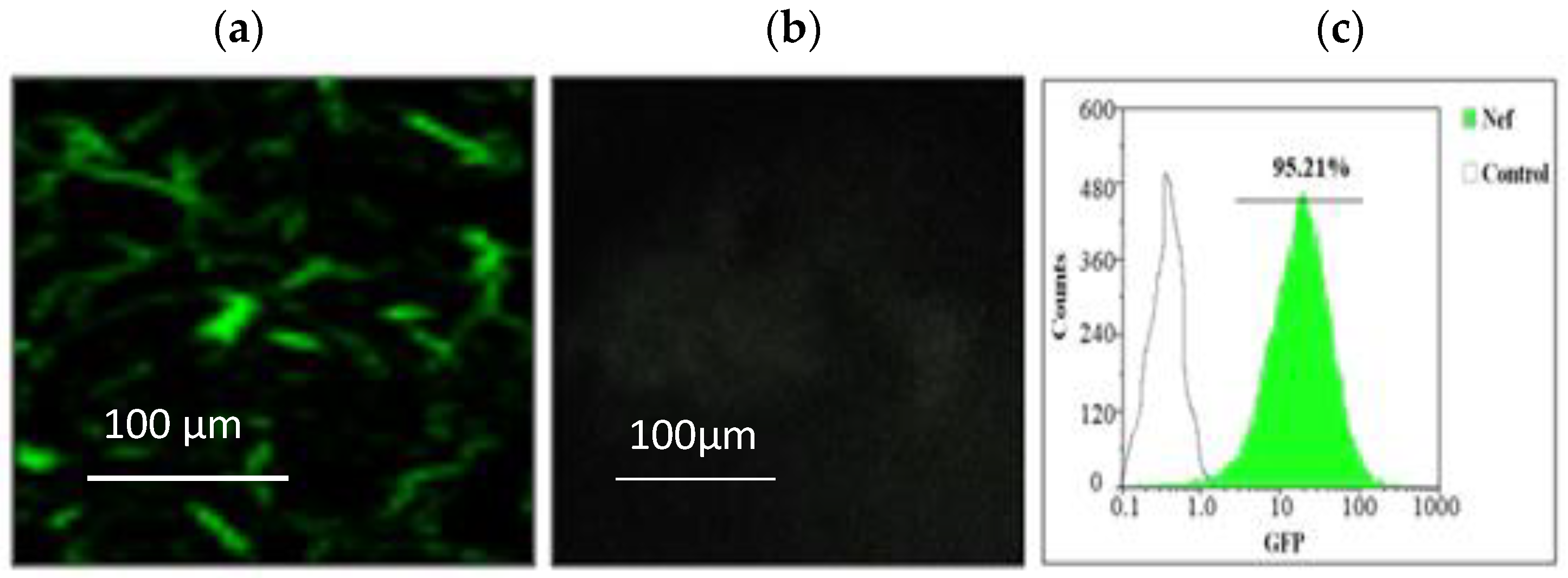
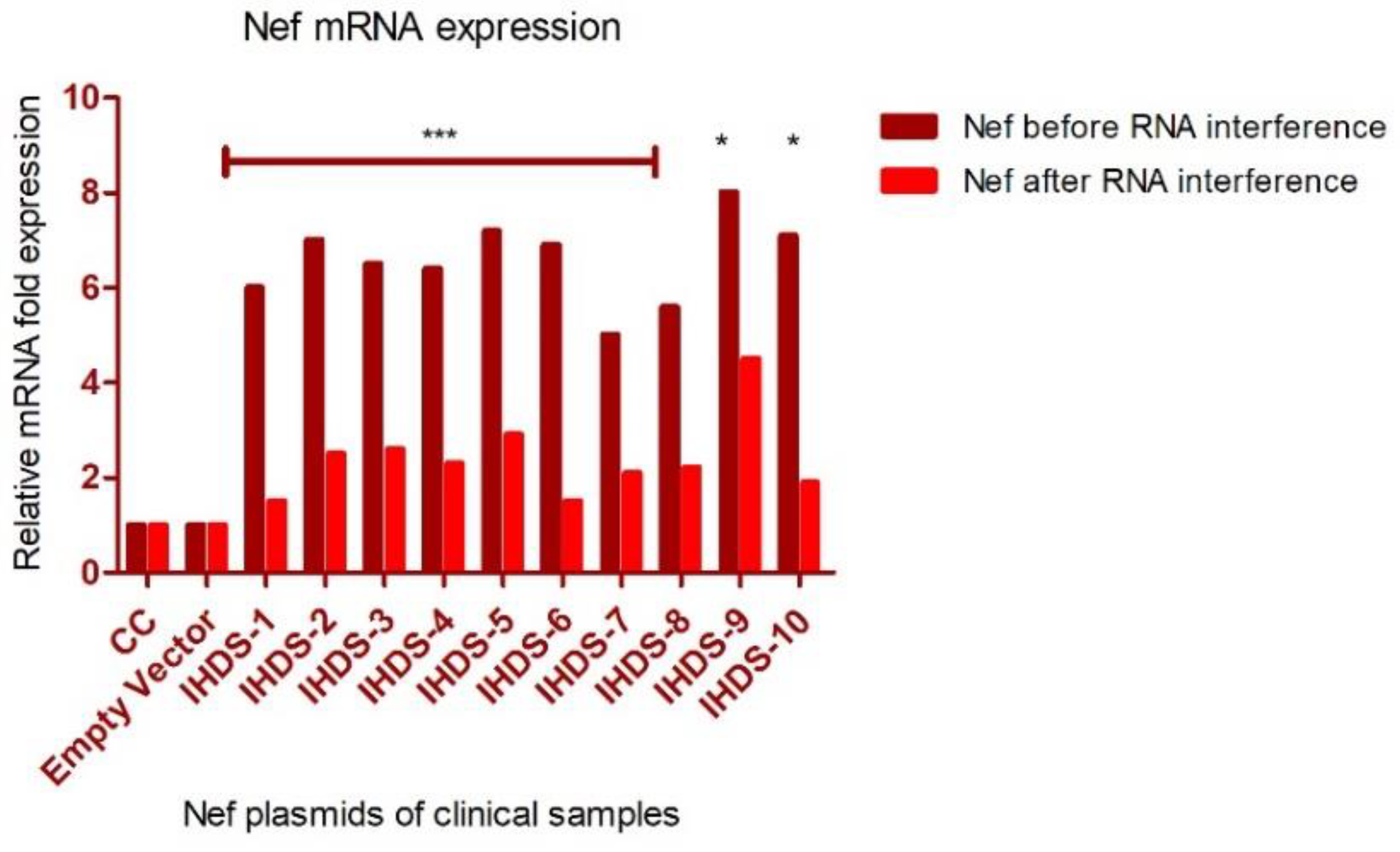
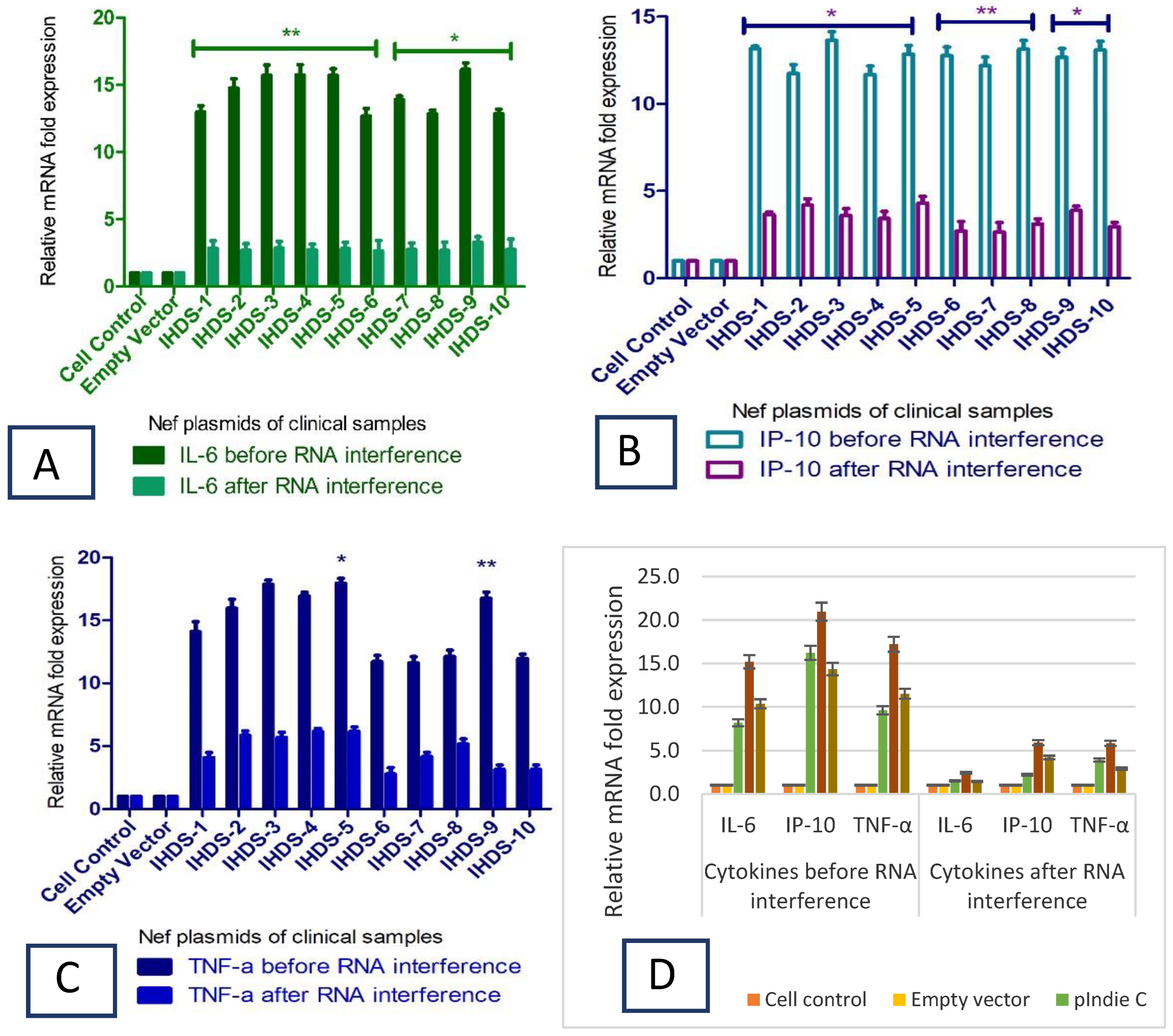

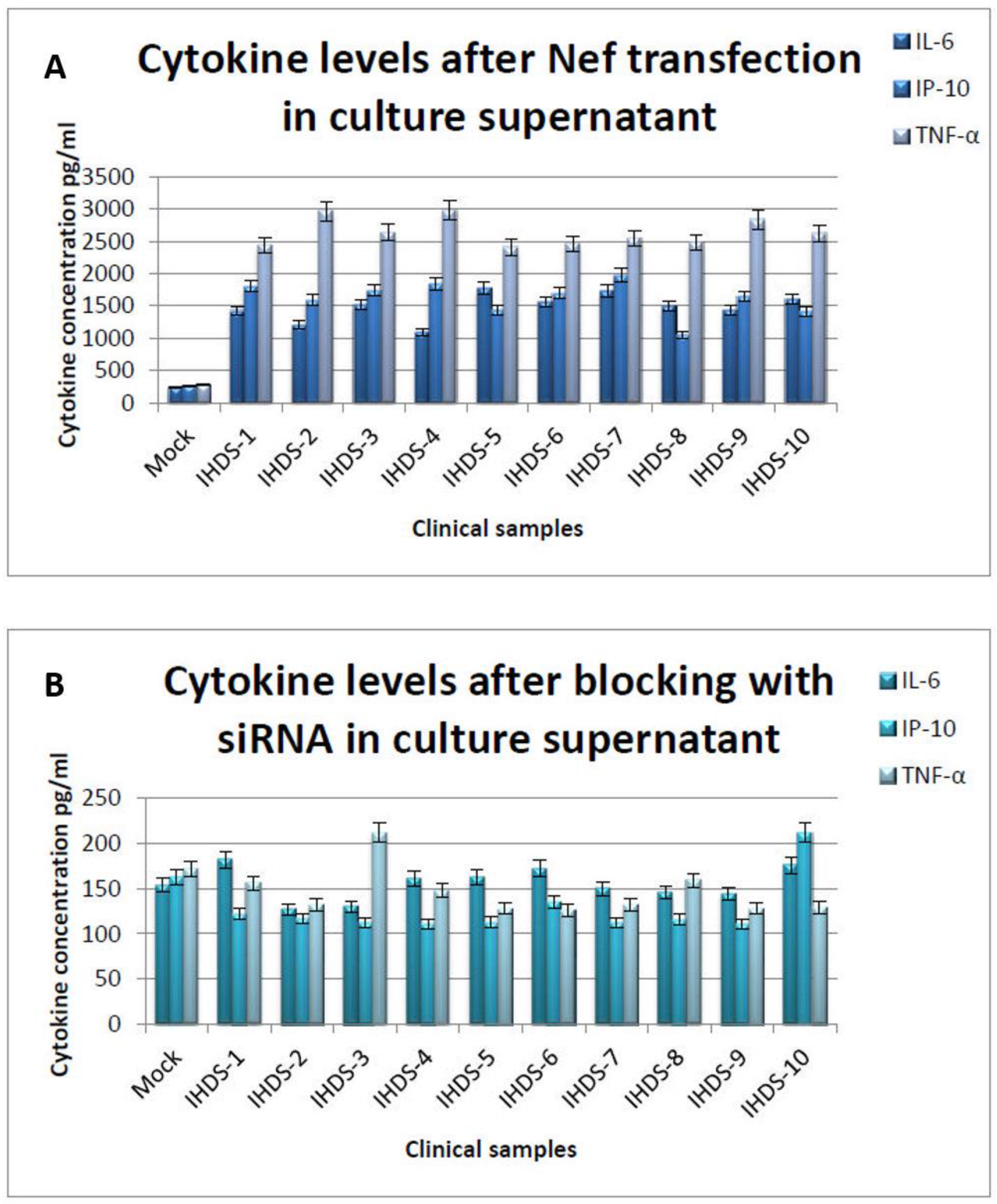
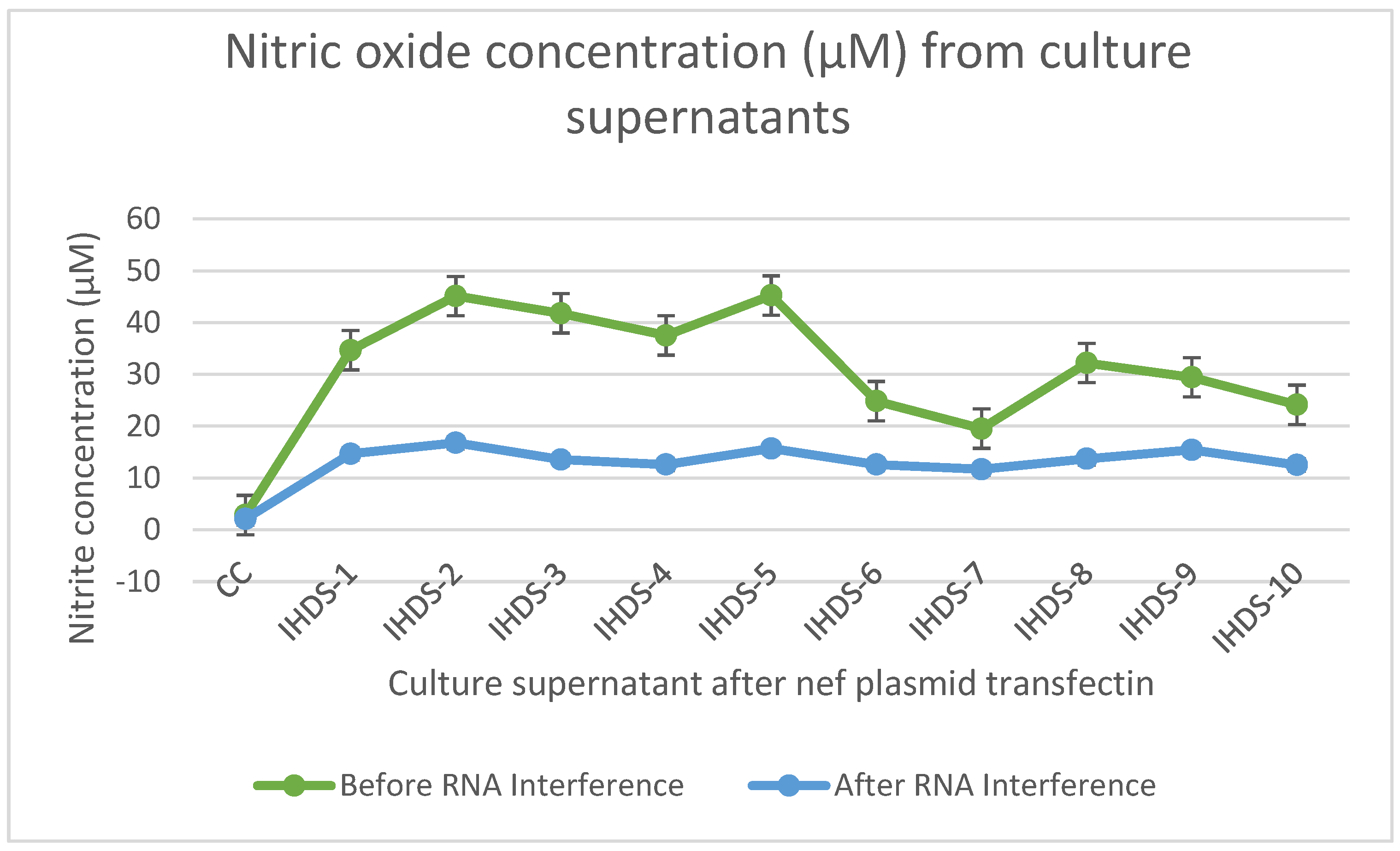
| IHDS * ID | Age | Sex | Mode of Transmission | IHDS * Score | CD4 Count (Cells/µL) | Viral Load (Copies/mL) | Clinical Findings |
|---|---|---|---|---|---|---|---|
| IHDS-1 | 45 | M | Heterosexual | 6.5 | 81 | 683885 | Pulmonary TB, Herpes Zoster, Oral Candidiasis |
| IHDS-2 | 34 | M | Heterosexual | 7.5 | 45 | 325290 | Herpes Zoster |
| IHDS-3 | 26 | F | Heterosexual | 7.0 | 36 | 2290000 | Herpes Zoster |
| IHDS-4 | 40 | M | Heterosexual | 8.0 | 60 | 412000 | Pulmonary TB |
| IHDS-5 | 35 | M | Heterosexual | 7.5 | 72 | 378577 | Pulmonary TB, Herpes Zoster |
| IHDS-6 | 29 | M | Heterosexual | 11.0 | 198 | 90100 | None |
| IHDS-7 | 42 | M | Heterosexual | 11.5 | 192 | 29386 | None |
| IHDS-8 | 34 | M | Heterosexual | 11.0 | 147 | 57086 | Herpes Zoster |
| IHDS-9 | 30 | M | Heterosexual | 12.0 | 193 | 68900 | Herpes Zoster |
| IHDS-10 | 47 | M | Heterosexual | 12.0 | 188 | 74845 | None |
| Sample Id. No. | Relative Fold Expression of IDO mRNA in NHA | Relative Fold Expression of HAAO mRNA in NHA | ||
|---|---|---|---|---|
| Before RNA Interference | After RNA Interference | Before RNA Interference | After RNA Interference | |
| IHDS-1 | 3.2 | 1.3 | 4.4 | 1.2 |
| IHDS-2 | 2.8 | 0.9 | 3.6 | 0.8 |
| IHDS-3 | 2.0 | 0.5 | 3.1 | 0.4 |
| IHDS-4 | 2.9 | 1.4 | 3.8 | 0.5 |
| IHDS-5 | 2.2 | 1.3 | 3.5 | 0.7 |
| IHDS-6 | 3.9 | 0.8 | 4.4 | 1.1 |
| IHDS-7 | 2.2 | 0.2 | 3.5 | 1.2 |
| IHDS-8 | 2.3 | 1.2 | 3.8 | 0.9 |
| IHDS-9 | 6.5 | 1.7 | 5.6 | 1.5 |
| IHDS-10 | 2.8 | 0.8 | 4.0 | 1.1 |
| pIndieC | 3.1 | 1.2 | 3.2 | 1.4 |
| pNL 4.3 | 4.5 | 1.5 | 5.1 | 1.2 |
| pLconsNefSN | 2.9 | 0.5 | 3.1 | 0.5 |
Publisher’s Note: MDPI stays neutral with regard to jurisdictional claims in published maps and institutional affiliations. |
© 2022 by the authors. Licensee MDPI, Basel, Switzerland. This article is an open access article distributed under the terms and conditions of the Creative Commons Attribution (CC BY) license (https://creativecommons.org/licenses/by/4.0/).
Share and Cite
Jadhav, S.; Makar, P.; Nema, V. The NeuroinflammatoryPotential of HIV-1 NefVariants in Modulating the Gene Expression Profile of Astrocytes. Cells 2022, 11, 3256. https://doi.org/10.3390/cells11203256
Jadhav S, Makar P, Nema V. The NeuroinflammatoryPotential of HIV-1 NefVariants in Modulating the Gene Expression Profile of Astrocytes. Cells. 2022; 11(20):3256. https://doi.org/10.3390/cells11203256
Chicago/Turabian StyleJadhav, Sushama, Prajakta Makar, and Vijay Nema. 2022. "The NeuroinflammatoryPotential of HIV-1 NefVariants in Modulating the Gene Expression Profile of Astrocytes" Cells 11, no. 20: 3256. https://doi.org/10.3390/cells11203256
APA StyleJadhav, S., Makar, P., & Nema, V. (2022). The NeuroinflammatoryPotential of HIV-1 NefVariants in Modulating the Gene Expression Profile of Astrocytes. Cells, 11(20), 3256. https://doi.org/10.3390/cells11203256






